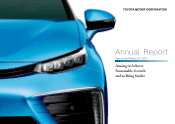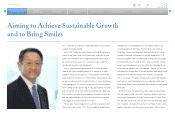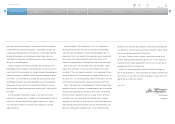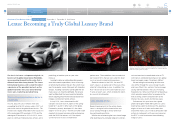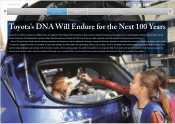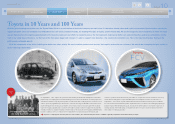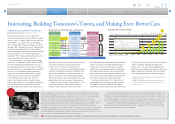Toyota 2014 Annual Report Download - page 3
Download and view the complete annual report
Please find page 3 of the 2014 Toyota annual report below. You can navigate through the pages in the report by either clicking on the pages listed below, or by using the keyword search tool below to find specific information within the annual report.
ANNUAL REPORT 2014
President’s MessagePresident’s Message
Overview of
Four Business Units
Overview of
Four Business Units
Special FeatureSpecial Feature
Review of OperationsReview of Operations
Consolidated Performance
Highlights
Consolidated Performance
Highlights
Management and
Corporate Information
Management and
Corporate Information
Investor InformationInvestor Information
Financial SectionFinancial Section
Page 3
NextPrev
ContentsSearchPrint
management structure enables each unit leader to adopt a self-
sustaining approach that makes the most of on-site, hands-on
experience, thereby facilitating quick decision making. This ability
to address individual requirements on a more detailed basis is all
the more important when considering the varying scales and stages
of motorization in each market. In 2014, we are taking this concept
of self-sustaining operations one step further by making better cars
on an individual platform basis. For example, “Team K” will assume
comprehensive responsibility for the development, procurement, and
production for models that employ the K platform, including the
Camry and Avalon. This greatly broadens the scope of the develop-
ment process, which had tended to focus on individual models, and
allows whole platform teams to channel their energies toward making
better cars.
In North America, the decision has been made to unify and relo-
cate the manufacturing, sales and marketing, corporate, and finan-
cial services headquarters at a new shared campus in Plano, Texas,
from the latter half of 2016. This will allow our North American opera-
tions to address the needs of customers in a timelier manner, and to
produce ever-better cars that exceed expectations. With a history
Aiming to Achieve Sustainable Growth
and to Bring Smiles
First, I would like to extend my sincere gratitude for your continued
support and understanding.
Since 2009, Toyota has encountered a multitude of challenges.
Thanks to the tireless efforts of all concerned, today we can take
pride in the strengths of our management practices and culture. I
am convinced that we are now in a position to take a definitive
step forward toward sustainable growth.
Just as a tree’s growth rings testify to its survival and growth,
I believe that Toyota’s ongoing growth rests entirely on its ability
to grow in the face of any adversity. Having recently achieved the
unprecedented milestone of 10 million vehicles in global Group sales,
we are now advancing into uncharted territory. If we are to achieve
sustainable growth, it is vital that we nurture our human resources
while building on each growth ring. It is equally important, however,
that we maintain self-restraint and avoid overextension. Balancing
these concerns and directing management resources to areas that
offer the potential for growth, we will pursue bold innovation and
make aggressive forward-looking investments.
For example, Toyota reorganized its automotive operations into
four business units in April 2013. This more agile and autonomous

